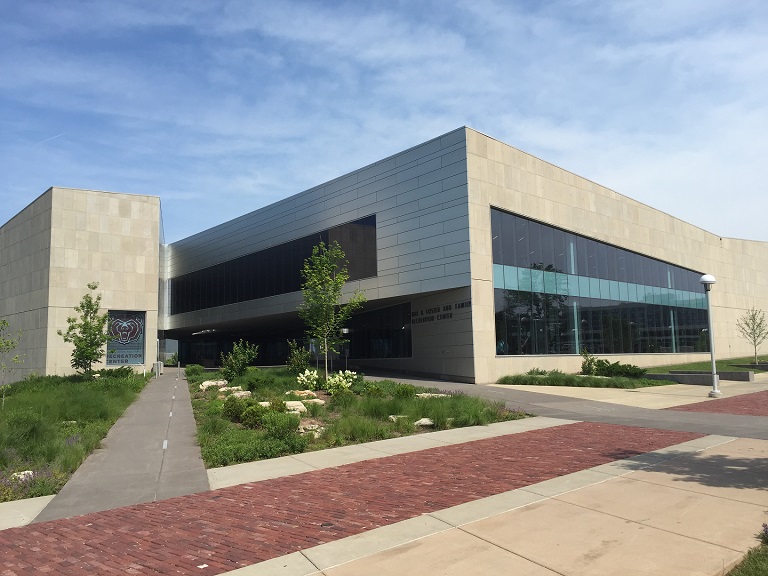Buildings
The Bill R. Foster and Family Recreation Center - LEED Silver Certified

Sustainable facts about the building
- Projected to have 20.3% in energy savings
- No ozone-depleting CFC-based refrigerants
- 92% of construction waste was recycled
- The building and campus is a smoke free environment
- Low-VOC paints, carpets, coatings, adhesives and sealants were used in construction
- Anticipated to have 41% reduction in water use
- Located near multiple bus lines with several bus stops within 1/4 mile
- The building has and will continue to serve as an educational tool for students and visitors
Interested in learning more? Consider taking a walking tour of the FRC that points out the sustainable features. Look for logos throughout the building and reference the Sustainable Features Brochure for a description of each sustainable element (you can also pick up a copy of this brochure at the Welcome Center of the FRC).
Walking Tour Sustainable Features
- Shower and Changing Facilities: Providing shower and changing facilities for the occupants encourages commuting to the building by bicycle.
- Recycling Receptacles: Recycling one ton of paper prevents the processing of 17 trees and saves three cubic yards of landfill space.
- Sustainable Wood Gym Floor: The negative environmental impacts of irresponsible forest practices can include destruction of forests, loss of wildlife habitat, soil erosion and stream sedimentation.
- Low VOC Paint: VOCs or Volatile Organic Compounds are carbon compounds that participate in atmospheric photochemical reactions VOCs can have a detrimental effect on human health.
- Native/Low Water Plants: Springfield receives an estimated 45" of rainfall each year. Plants native to the region can survive on rain alone and don't need additional watering.
- Bicycle Storage: Bicycle commuting produces no emissions and has zero demand for petroleum-based fuels.
- Carpet Tiles: If an area of carpet gets stained or damaged only the affected tiles can be removed and replaced which reduces the amount of carpet that is sent to the landfill.
- Controllability of systems: Providing task lighting at individual work spaces promotes productivity, comfort and well-being of building occupants.
- Natural Light: Studies show that when people live and work in a well lit environment they are happier and healthier. Natural light has been shown to limit eye strain and lessen energy consumption.
- Low-E Coating on Windows: Low-emissivity (Low-E) coatings control heat transfer through windows with insulated glazing and reduce energy loss by about 30%-50%.
Building Design and Construction
Both the University and the State are making great strides in green building construction and renovation. These efforts will help the campus conserve energy, reduce the use of raw materials, and save money. Over time, more members of the campus community will live, work, and learn in increasingly efficient buildings while enjoying a higher standard of indoor environmental quality.
Building Sites
Among other criteria, building sites are selected based on the ability to:
- Provide access to public transportation
- Restore habitat
- Filter storm water runoff
Design Criteria/Facility Standards
The University has developed standards and design guidelines for new construction and building renovations on the Missouri State University campus. These guidelines are used by the design team to meet the programmatic needs of each project and cover topics including operations and maintenance, safety, energy efficiency, and material finishes. To insure the University's projects are designed in compliance with the University's green building commitment, our design criteria and facility standards are being revised to address environmental stewardship and LEED design criteria.
Each new building is designed with a focus on:
- Maximizing open space
- Facilitating community connectivity
- Providing views from 90% of regularly occupied spaces
- Including priority parking for car-pool and fuel-efficient vehicles
- Planting native or adaptive landscaping that does not require irrigation
- Reducing light pollution
Construction Practices
Missouri State University's commitment to sustainability pairs well with the growth of our campus. Our focus on sustainable construction includes designing and building all new projects to green standards, including those set by Leadership in Energy and Environmental Design (LEED).
Our sustainable construction process includes:
- Having a LEED Accredited Professional (AP) on the design and construction team
- Using local and recycled building materials, Forestry Stewardship Council (FSC) certified wood, carpet and paint with low-emitting volatile organic compounds (VOC), and composite wood that contains no added formaldehyde resigns
- Protecting HVAC system from dust and moisture during construction
- Controlling the source of chemicals and pollutants from entering occupied spaces
- Preventing pollution from construction activity
- Diverting 50% - 75% of construction waste from landfills
Energy Efficiency
Completed buildings will include the following energy efficiency measures:
- 20%-30% reduction in water usage
- Access to lighting control
- Storage and collection of recyclables
- Fundamental and enhanced refrigerant management
- Exceeding minimum energy performance by at least 14% and providing fundamental and enhanced commissioning of building energy systems
- Exceeding minimum indoor air quality (IAQ) standards, prohibiting smoking inside the building and away from entrances and ventilation intakes, and monitoring deliver of outdoor air
- Green housekeeping procedures
More information can be found on the Planning, Design and Construction website.